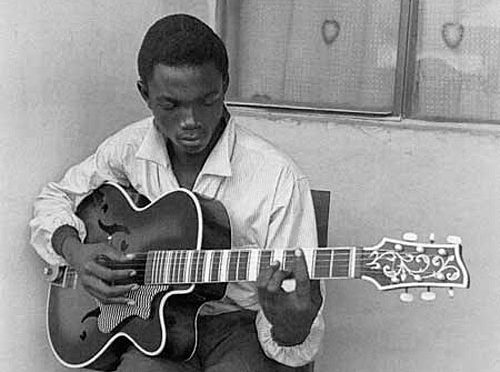Like Dakar, Bamako, or Nairobi, Kinshasa, the capital of the Democratic Republic of Congo (DRC), is one Africa’s great cities for music and has been for some time. Some would argue that Kinshasa has eclipsed the other cities in terms of producing music that has dominated all of subsaharan Africa. It is debatable. One photographer Jean Depara spent an entire lifetime participating and photographing Kinshasa’s night life and urbanity, leaving behind him brilliant photographs that illustrate the gourmand consumption of Congolese rumba in Kinsasha and the world of emotions that propelled the rise of the musical powerhouse soukous.
Jean Depara was born in Angola but made a name for his self as a photographer in DRC. He focused Kinshasa’s nightlife from the 1950’s to the 1970’s, when he became an official parliamentary reporter in 1975. At the heyday of Depara’s career, around the time and right after “Les Independances” or when African nation states became independent, the great name in DRCongolese music was Franco. Franco, short for Francois Luambo Makiadi, like many other African musicians, was first well known for playing in an orchestra that fused Afro Latin American and African rhythms, OK Jazz.
Cuban rhythms were especially beloved in many African cities and it was the case in at first the Belgian Congo and then in the many names that the DRC has gone by where a Congolese rumba was developed. Franco not only played a terrific guitar but was also an incredible vocalist. He was the king of songs that hid messages and often political messages. OK Jazz would go on to develop into TPOK Jazz and become one of the country’s major figures in the soukous movement and dominate the music of subsaharan Africa in general. It would soon be globally recognized.
In 1954, Depara became Franco’s official photographer. He was granted access to the life that fed Franco’s music. TOPK Jazz’s only real rival was Grand Kalle et L’African Jazz who were well known for the phenomenal “Independance cha cha cha,” though Zaiko Langa Langa and Tabu Ley Rochereau were as well known on the music scene though not as well loved. They all thrilled Kinsasha. In addition to Franco’s TPOK Jazz and its rivals, there were many other groups. DRCongolese groups were the major acts of subsaharan African music of the time both in terms of popularity and critical acclaim.
Depara’s subjects were often under strain though it does not seem to be the case. As Latin-African fusion and eventually soukous made their way into DRCongolese hearts, DRCongo’s politics began to know its highs and lows. The much loved Prime minister Patrice Lumumba was violently followed by Kasavubu and then violently by the dictator Mobutu Sese Soko in 1965 until 1997.
By the beginning of Mobutu’s reigns, DRCongo’s great orchestra and Kinshasa’s nightlife were already in existence. With Mobutu came a time of general absurdity that included both harsh dictatorship but also a campaign of authenticity and of pride in one’s own history. The DRCongolese people, for some time renamed Zaire by Mobutu, lived to the rhythm of daily national life imposed by Mobutu Sese Soko as much as they did to Soukous and their other musical rhythms. The people of Kinshasa’s continuing to attend nightclubs and their living along to DRCongolese’s many musical rhythms created the sort of life that fed soukous and the songs of Franco.
Jean Depara captured the emotion in Kinshasa’s living that came from cultural glory and from political doubt; the living that fed music’s brilliance and perpetuity.
headline photo: Congolese rumba master Franco – Photo by Jean Depara


